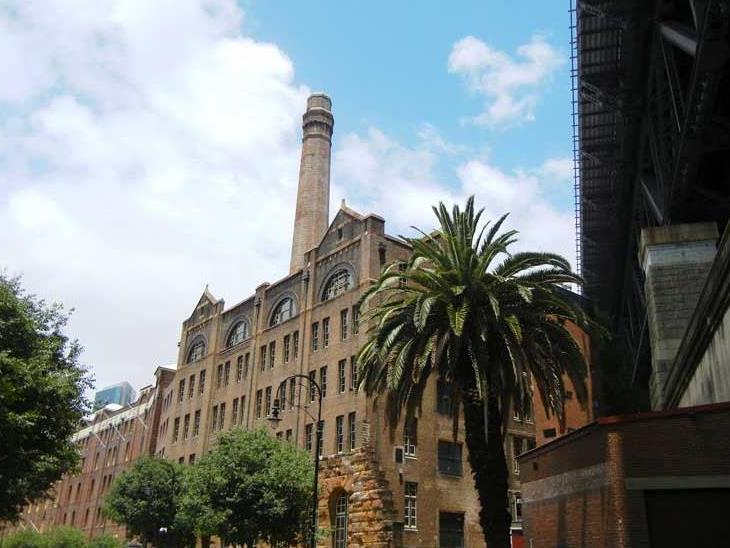In a mass e-mail, the Biennale of Sydney announced this week that it has moved its office to The Arts Exchange in The Rocks, leaving its home of 22 years in The Gunnery, another building asset of Arts NSW.
‘The move was an initiative of Arts NSW to co-locate Sydney’s major festivals,’ said Danielle Earp, Acting Chief Executive Officer when asked about the relocation’s funding.
It is no secret that the Biennale of Sydney had long outgrown its premises at The Gunnery, one of the buildings original tenants when it opened in 1992, from which it staged its 9th edition of the exhibition. The mere numbers in staff and program output has leapt into another stratosphere since then; the staff team currently sits at 25 which, of course, mushrooms during “Biennale season” with an army of volunteers. Space is a premium asset.
Earp said the new office was similar in size but had a clever use of space. ‘For example, there is a shared breakout area which will be utilised by the different tenants during their respective festival periods,’ said Earp.
The news of doors opening to a new future at the Biennale comes as a change in tone after a period of “closed doors” with media scrutiny and a cancelled panel discussion over their split with founding sponsor Transfield Holdings in March, after boycotts by artists because Transfield Holdings is a major shareholder in Transfield Services, which manages asylum seeker detention centres.
But the announcement hardly came as an embrace of “the good story moment”. The Biennale has not championed this milestone until now, and their comments remain guarded and antiseptic. Perhaps it is the continued fallout or an organisation recoiling and recounting before it again flings that door wide open?
The organisation remains under considerable pressure. The Minister for the Arts Senator George Brandis has effectively threatened to withdraw Federal finding because the Biennale refused private funding ‘s decision to split with Transfield. It needs to find a partner to replace Transfield, a difficult proposition given that corporate partners are always hard to find and they are likely to duck for cover at the slightest whiff of controversy.
On the other hand the 19th Biennale was both an artistic and a popular success, holding attendance despite the controversy and attracting 623,000 visitors, nearly 125,000 from overseas, the highest international visitation numbers recorded in the Biennale’s 41-year history,
The move is just one of a number of changes the Biennale currently faces – a new space, new CEO, a board shuffle – sounds like the rug is getting a good shake?
Earp told ArtsHub: ‘By its nature, the Biennale culture embraces change with a new Artistic Director for each edition. The formal process of CEO recruitment has commenced and we’re in great hands with our interim Chair Andrew Cameron. We are also looking forward to announcing the incoming Artistic Director for the 20th Biennale (2016) soon.’
The Arts Exchange was the obvious move for the Biennale, and clearly one that has been in the planning for some time. An Arts NSW spokesperson told ArtsHub, ‘that it had been ‘in discussions with all tenants since 2012.’
The Arts Exchange is a six-floor heritage building nestled under the Harbour Bridge at Hickson Road in Sydney’s Rocks area. A former power station, the site was acquired by Arts NSW in 1999 and was converted to office accommodation for arts organisations.
The Biennale of Sydney will join tenants: The Sydney Festival, The Sydney Writers Festival; The Australian Ballet; Friends of the Ballet, The Sydney Film Festival and Australian Major Performing Arts Group.
‘The clustering of like organisations is at the core of Arts NSW’s policy in providing accommodation support to the arts and cultural sector in the portfolio of properties it manages. Co-location supports efficiencies and innovations such as with festivals, which are more easily able to share seasonal staff when they are in the one building,’ said Arts NSW.
‘This is the first time all four of Sydney’s major festivals have been located in the same building,’ they added. ‘The refurbishment is enabling Arts NSW to accommodate more arts organisations in the building than ever before. To date, three floors have been completed. Once completed, the building will house more than 12 organisations.’
Worked commenced in 2013 to refurbish the building and turn it into a ‘Festivals House’, an operations hub for Sydney’s major festivals and key arts organisations promoting sharing of ideas, resources and services.
‘These organisations will share meeting rooms and facilities and ‘ramp up’ spaces which will assist the Festivals in particular as they expand and contract their operations at different times of the year.’
Earp added: ‘This is a great initiative by Arts NSW and, along with our new neighbour organisations, discussions about the move started in 2012. It was certainly no secret…We sent an e-card on Monday to ensure all of our partners and stakeholders had our new contact details.’
The project is expected to be completed in the first half of 2015. And, as Earp said: ‘Arts NSW has done a lovely job of the offices.’Arts NSW manages eight properties in and around the Sydney CBD, supporting over 30 arts organisations through subsidised accommodation.
The Biennale’s lease at The Arts Exchange commenced on 7 July 2014.





